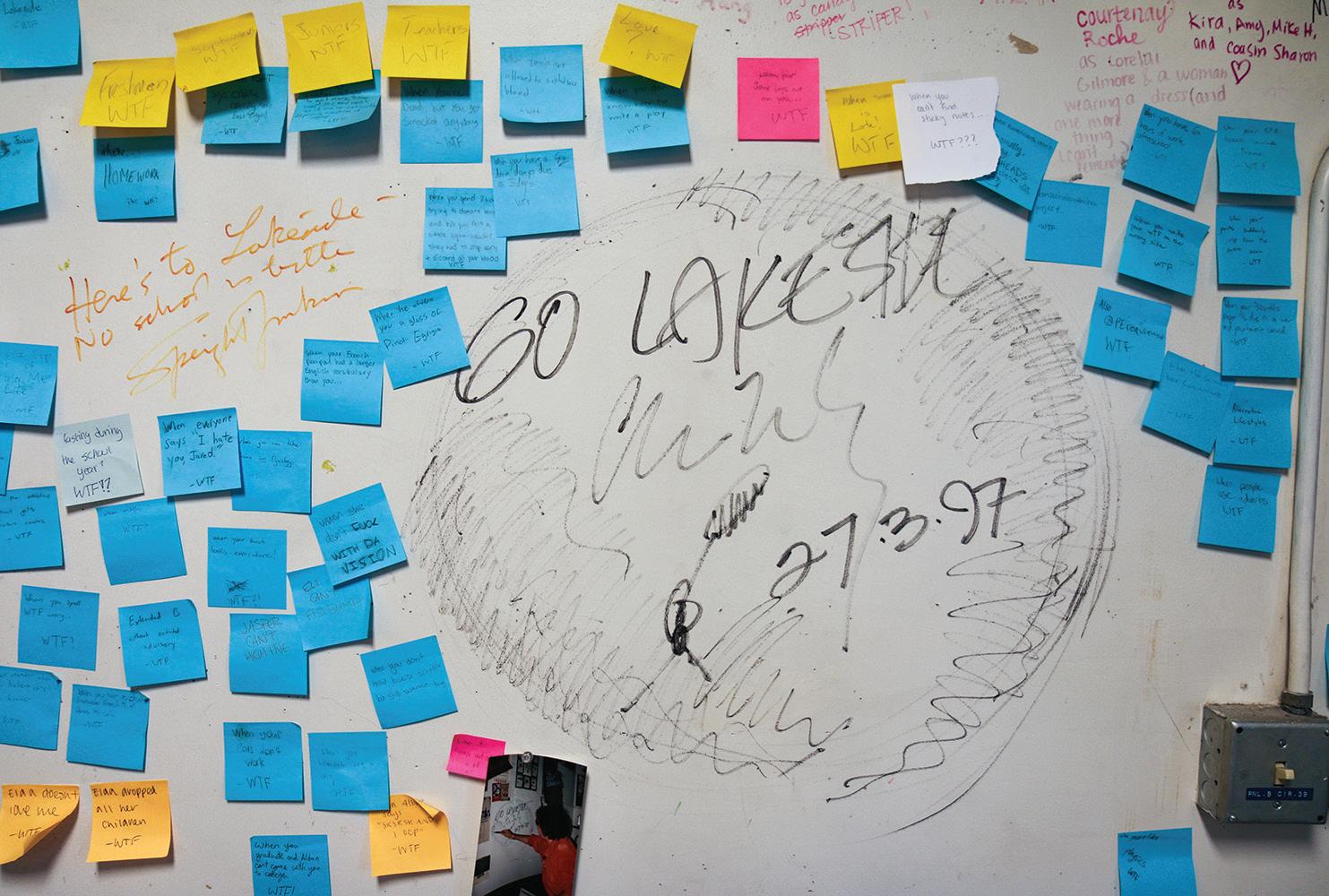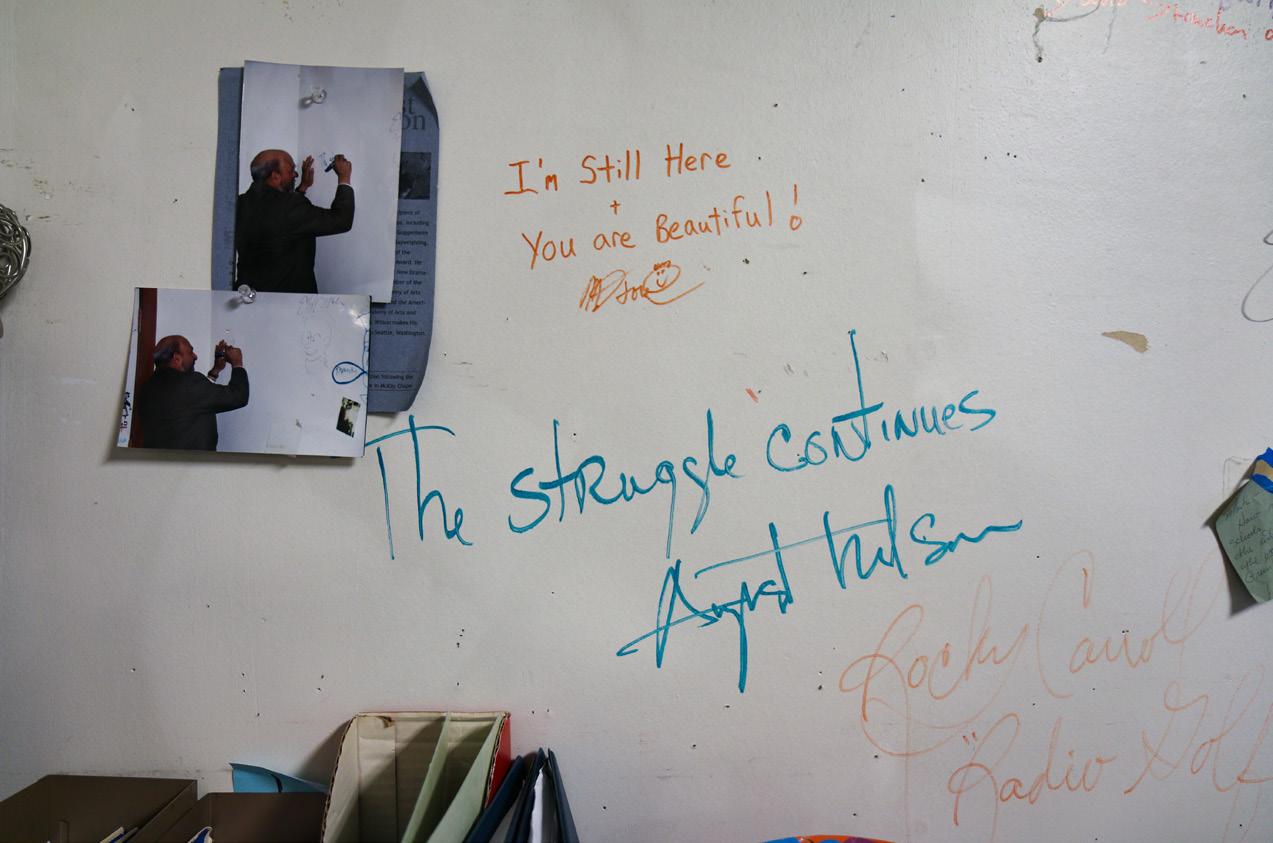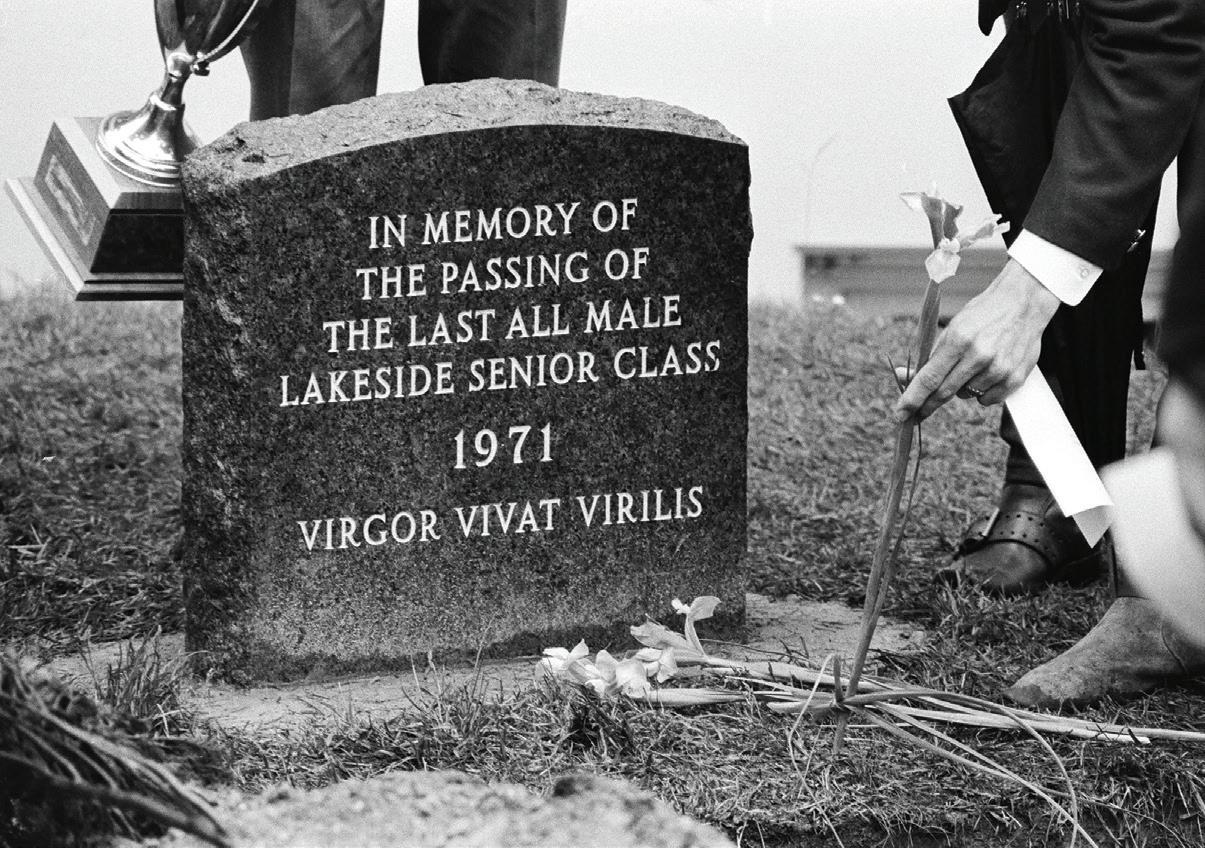
7 minute read
From the Archives
inside lakeside
FROM THE ARCHIVES
What Gets Saved
RECENTLY, UPPER SCHOOL drama teacher Alban Dennis visited me in my office with an interesting question. “Is there any way to stop the signatures on the walls of my office from fading?” He was referring to two signatures in particular: those of glass artist Dale Chihuly, the Dan Ayrault Memorial Lecturer in 1997, and playwright August Wilson, who came to campus and spoke two years after that. Each had used a felt-tipped marker to sign the office wall, their autographs mixed in with those of art students from decades back. Sadly, I wasn’t able to offer a magical solution. Ink fades, even permanent marker ink. Over time, those autographs will eventually disappear. But Alban’s question got me thinking about history, historical markers, and the passage of time. It’s not only visiting artists and student performers who leave their marks on the school; students long graduated are memorialized on the walls of Bliss Hall’s bell tower, on wallboard cut from the building’s fourth floor before its transition from art department to staff offices, and, in one case, on a 700-pound tombstone planted in the grass to the north of McKay Chapel. These marks have been left deliberately, proudly, possibly with the expectation that they will be there as long as the school remains. But what happens when markers represent, or even celebrate, past attitudes that conflict with the school’s current values?
Shortly after I became archivist at Lakeside, I received a tour of Bliss Hall’s bell tower, a privilege granted to seniors and staff upon special request and only when accompanied by members of the maintenance team who have keys (and hard hats). Maintenance foreman Rob Burgess and I ascended the pull-down ladder into a cramped but light-filled wooden interior, student signatures and graffiti of all sizes and colors adorning the walls. The old bronze bell still sits on the floor one level up, no longer in use, itself a victim of long-since-graduated seniors wielding paintbrushes. There are inscriptions up there, though I didn’t notice them, that are offensive. Many years ago, I was asked if I thought they should be painted over. My thinking then was that history is not always pretty. It often directly conflicts with our current values and ethics. Yet the presence of offensive history provides us with a prompt for addressing past values (and policies and attitudes) and coming to terms with them, to apologize for them, and work to repair damage done by them, ultimately creating a path forward. If you paint over those inscriptions up in the bell tower, you deny that they ever existed, along with the suffering of those they may have harmed. Essentially, in this case you literally whitewash history. And by doing that, you risk blocking any attempts at truth, reparation, or reconciliation.
Bliss Hall’s fourth floor (also, for a time, known as the “attic”) has been many different things. In the 1930s and ’40s, it was home to Lakeside’s Rifle Club. Legend has it that before that floor’s renovation, the walls still showed bullet holes. Photos of the space during its art department days, from the ’60s to the late ’90s, exude a mix of rebelliousness and insight that simultaneously attracts and repels. There’s a sense that students were given free rein to write or draw whatever they wished, whatever was deemed normal and acceptable for teenagers at the time. When Pigott Family Art Center was built and the fourth floor of Bliss was renovated to serve as offices, parts of the old wallboard were cut and framed to be mounted on the walls of the new arts building. I asked Al Snapp, former art department head and longtime faculty member, what the intention was for those pieces. He couldn’t recall who decided what to save, though he did remember that the pieces were intended to adorn
The signatures of glassmaker Dale Chihuly (above) and playwright August Wilson (below) have become a part of the drama department's visual history. What happens when even permanent marker proves not to leave a permanent mark? Archivists have no simple answers.

the walls of the new building only temporarily, until new student art could be shown. The sections chosen were paintings of the Beatles and of their Yellow Submarine, homages to pop culture of an era. But it was the students who had created them, who expressed their own interests and attitudes through them, who had marked the space as their own, that imbued meaning into that art. When the school selected sections and removed and framed them for display in the new space without context or explanation, did the meaning fall away?
When thinking about how to preserve the Dale Chihuly and August Wilson signatures on Alban’s office walls, the idea to cut them out and frame them behind UV-protective glass occurred to me. But even though that would prolong their existence, it wouldn’t preserve their meaning. I would argue that if we are to honor the marks that past artists and students have made on Lakeside’s campus, we need to preserve — and provide the viewer with — the context in which they were created. It is the context of these markings that creates meaning. Context is a powerful thing; it’s an essential part of understanding and thinking critically about our history.
Lack of context can do more than erase meaning, however; it can also cause harm. Trouble arises when historical markers representing past attitudes or beliefs are displayed without the benefit of historical context, especially when those markers celebrate attitudes of the past that conflict with contemporary values. Take, for example, the polarizing debate around Civil War-era statues throughout the country.
Or take, for example, that tombstone by McKay Chapel. A gift of the last all-male class to graduate from Lakeside before the school merged with St. Nicholas and became coed, the granite stone was conceived by several members of the class of ’71 as a way to memorialize a school that would be no more: Lakeside School for boys. What I discovered nearly a decade ago while researching the merger between Lakeside and St. Nick was that the students who planted the tombstone weren’t anti-coeducation. Rather, they explained that they had cherished the experience of an all-boys school and wanted to mark the “death” of the “Lakeside boy” as they knew him. Their intentions, they believed, were not chauvinistic. At the time, this seemed reasonable to me. The intention was to celebrate a bygone era, after all. The school was moving on.
It's been nearly 10 years since I did that research. I’ve had many conversations with members of the faculty, staff, and administration since then. I’ve attended several workshops dedicated to diversity, equity, and inclusion. Today, it seems to me that regardless of intention, it is the impact of a marker that ultimately matters.
Early this year, I heard from a colleague that her advisory had had an emotional discussion about the tombstone. She said students couldn’t believe that something so misogynistic, so blatantly anti-Lakeside values, hadn’t been removed. My first reaction was to lament the absence of context. Community members just didn’t understand the intent of the marker! But later, during a discussion with Upper School history teacher Nancy Rawles, I was struck by her words and reminded of all the school’s equity and inclusion work I had been a party to. Rawles pointed out that the language on the public-facing side of the tombstone, “In memory of the passing of the last all male Lakeside senior class,” was problematic. If we substituted “male” for “white,” she asked, would the tombstone — context or no — still stand?
I had heard this very argument from a former faculty member, but my response had always been that Lakeside wasn’t a chauvinistic school, that the young men who planted the tombstone didn’t want to restrict entrance to young women — I reasoned that the substitution of “male” for “white” didn’t equate because there wasn’t a history of intentional exclusion at Lakeside. But I realized for the first time that the intent made no difference. The language itself celebrates a time before young women (or, rather, non-males) were welcomed into the student community. It suggests that their inclusion meant the death of the former institution, and that that death was cause for mourning. And, though the change may have felt like a death to some alumni, does that justify that a public marker, erected by a small group of students, remain 40 years later on the lawn of Lakeside, a school with a deep commitment toward academic excellence, diversity and inclusion, global engagement, and ethical spirits?
Lorelei S. ’25 who writes for Tatler, was among the students in my colleague’s advisory. She reached out to me for more information about the tombstone, and later convened a conversation with the ’71 alumni who planted it and would

Seniors in 1971 planted the gift of a tombstone symbolizing the death of their all-male era. Does such a monument continue to deserve a place on today's changed campus? Who, in the end, should decide?
Continued on page 15










